Budapest for Physicists
We all know about the contributions to physics made by John von Neumann, Leo Szilard, Edward Teller, and Eugene Wigner. They all came from Budapest, Hungary. Wigner and von Neumann came from the same high school. Janos Harsani (1994 Nobel in economics) also came from this high school.Thus, our first stop in Budapest should be this high school, which we call Wigner's High School for convenience. It is not far from the center of the city, and within a walking distance from Hero's Square. Here is the map.
- Click here or
click on the above map for
a webpage dedicated to this high school. I went there twice, and the webpage
contains many interesting photos.
- In 2012, the Hungarian
Academy of Sciences inaugurated the Wigner Research Center Physics. With its
excellent leadership, the Centre has a very bright future.
- The Academy building is on the east bank of the Danube near the Chain Bridge.
- This photo tells exactly where this building is. It is within a walking distance from the Parliament building.
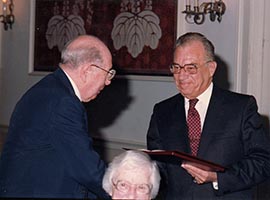
- 1988, Eugene Wigner was admitted
to the Hungarian Academy of Science. In this photo, his membership
certificate is awarded to Wigner by
His Excellency Wenzel Hazi, the Ambassador of the Hungarian People's
Republic to the United States.
This ceremony took place during the conference I organized in commemorate the 50th anniversary of of his 1939 paper on internal space-time symmetries of elementary particles. I devoted a substantial portion of my research efforts to understanding and further development of this paper. See my Wigner page for further information.
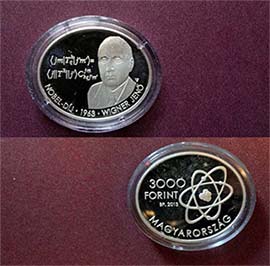
- In 2013, the Central Bank of
Hungary issued Wigner coins. Very proper thing to do!
- In 2013, the
Wigner Centre hosted an international conference entitled Wigner 111
Scientific Symposium. The Centre invited me to present a paper at
that conference.
- Click here
for the talk. This talk tells how I approached Wigner. You will be
interested to hear that I approached him by explaining to him
Steven Weinberg's 1964 paper on massless particles.
I have converted my Powepoint presentation into a series of webpages, with a quick response for each page. You do not have to wait for five minutes to download the entire file. I am developing this "Remote Point" software as my new venture. Your suggestions are welcome.
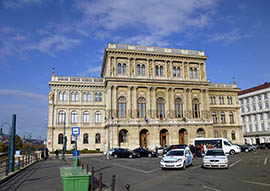
- In 2012, the Hungarian
Academy of Sciences inaugurated the Wigner Research Center Physics. With its
excellent leadership, the Centre has a very bright future.

|
There are other interesting places in Budapest. The River Danube flows from north to south and divides the city into two parts. Buda on the west and Pest on the east.
- The most prominent structure on the eastern bank of the River is
the House of the Nation.
Click here for the Wikipedia page for this parliament building.
- Parliament building seen from the Royal Palace (higher ground) on the west bank of the River.
- seen from a River boat.
- Close-up view from the River.
- A ceremony taking place in front of the building.
- Entrance to the building with Hungarian soldiers.
- Those soldiers were carrying Soviet-designed Kalashnikov rifles. I asked one of the Hungarian spectators where those rifles were made. He said "in Hungary of course." I then asked whether it was originally designed by a Russian for the Soviet Army. He said "No. It was invented by a Hungarian engineer!" He was an OK Hungarian.
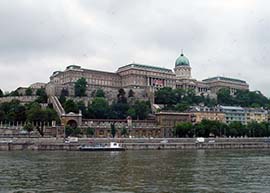
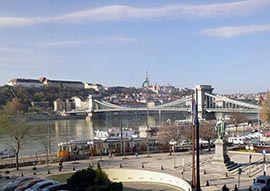
- On the other side of the River
is the Royal Palace on the Castle Hill. This photo was taken
from the east bank of the Danube.
- I am not able to explain the history of this castle. Wikipedia page for further information.
- The Mathias Church or the Buda Cathedral is also on the high ground of the west bank. This photo was taken from a fifth floor hotel room at the Hotel Sofitel Chain Bridge. The hotel window was somewhat dusty. Click here for the history and more photos.
- The big building next to the Church is the Hilton Hotel.
- The wall with towers is called Fisherman's Bastion.
Click here for its history.
- The Chain Bridge across the Danube is the major bridge between the two parts of the city. Here is a night view of this bridge.
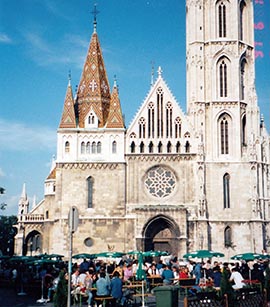
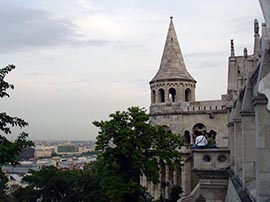
- Let us cross the bridge and climb up to the Castle Hill. They seem to
have their own civilization there.
- Tall Tower of the Mathias Church.
- Entrance to the Church. People are having a good time on the church ground.
- Beautiful roof, unique design, and more roofs.
- On the Church ground, interesting events take place always. There was a big crowd when I went there in 1997.
- These young people are showing off their talents.
- A horse-loving Hungarian
can also be seen.
- Fisherman's Bastion is around the the Church. This place was built originally built by local fishermen to defend the hill area. It was built for military purpose, not for fish market.
- From the Wall, tourists are looking at the other side of the Danube. To them, the Parliament building appears like this.
- Many tourists come to this area.
- In 2008, I met two American
college graduates there. They were roommates at the University of
Washington in Seattle and were making an after-graduation tour in Europe.
They were enjoying their new freedom. When I told them I am a professor
at the University of Maryland, they became very happy to have this photo.
I assume they are now well-established professionals. I like to see them
again.
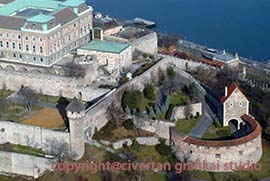
- The Royal Palace is about 800 meters south of Fisherman's Bastion.
- It is The back of the castle is a peaceful place.
- One of the monuments is here, but I cannot explain its history. There are many more.
- There are many small buildings, is here, presumably for government offices.
- This young artist is concentrating herself on her art work.
- About kilometers south of the Castle Hill, there is a new campus of
Eotvos Loland University. The origin of the University can be
traced to a Jesuit college set up in 1635. During the course of history,
the school grew in size, changed its name, and changed its location.
In 1921, the school became the University of Budapest. It became
Eotvos Loland University in 1950.
Needless to say, its name came from Loland Eotvos (1848-1919) who proved the gravitation mass is the same as the inertial mass. The new campus of the University is on the west bank of the Danube south of the Castle Hill.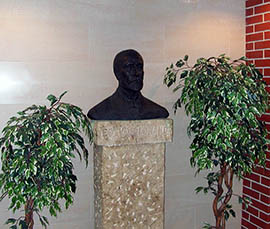
- This is a bust of Eotvos in the physics building.
- This shiny corridor is also in the physics building.
- Seen from the Danube. East side of the Campus.
- The entrance to the main building on the west side of the campus.
- The main library. This high-tech library tells also that the university has its history.
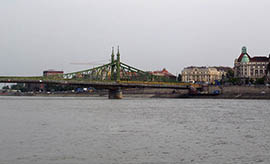
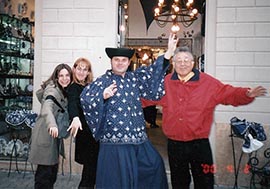
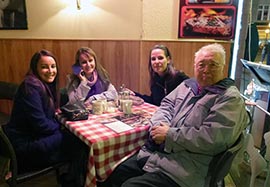
- After seeing the Eotvos campus, you can cross the
Elizabeth Bridge to come back to the
east bank of the Danube. This bridge has
its history.
- Soon after leaving the bridge, you will reach the southern end of Vaci Street. This pedestrian street is runs through the main shopping area of Budapest. There are shops like this and like this.
- Here are more photos of this street.
- During the evening hours.
- To me, it is more exciting to meet interesting people.
- I met this set of people consisting of one Hungarian man dressed like a Mongolian, and two visitors from Spain.
- I met these two shop keepers while taking a cigaret break.
- I met these Two Hungarian sisters at one of the restaurants.
- I met these Three French-speaking ladies. One of them came from Budapest, and two are from Montreal, Canada (They speak French there). All three of them could speak English, and I was able to communicate with them with English.
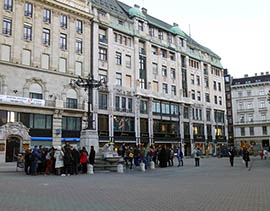
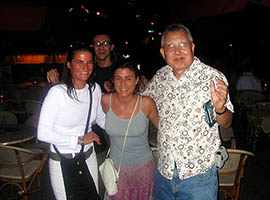
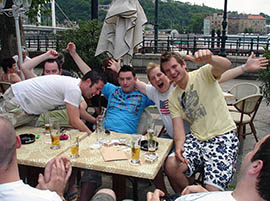
- The Vorosmarty Square
is at the northern end of Vaci street. This wide-open area is
surrounded by restaurants, cafes, and other meeting places.
- The entrance to Vaci Street
is seen on the left side of this photo. The entrance looks
like this during the evening hours.
- This new structure does not seem to be in harmony with traditional buildings in this area. But new waves are going to hit this area and will change the landscape.
- Another fun-filled side street branching out from the Square.
- The entrance to Vaci Street
is seen on the left side of this photo. The entrance looks
like this during the evening hours.
- The Vaci culture is alive and well in this area.
- Everybody is everybody's friend in this area.
- I was able to produce my photo with two Australian ladies at an out-door drinking place in the summer of 2003. They came from England. They were working there and came to Budapest for vacation.
- This lifestyle continues along the streets leading to the Danube bank. These young men are from England for vacation. I asked them whether they speak English, and this was their response.
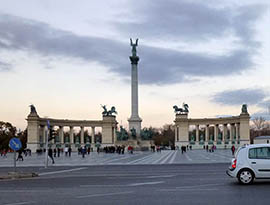
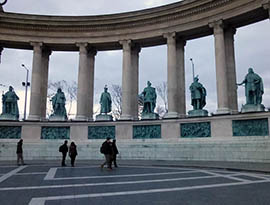
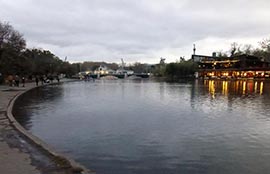
- This Square is close to five-star hotels along the east
bank of the Danube, and its Metro station is very busy.
The Metro Line 1 starts here. It stops at the Opera
House, the Franz Liszt Square, two blocks north of
Wigner's high school, and then Hero's Square. Let us go
to Hero's Square.
Click here for a map.
- This is the Metro station at the Square.
- This a front view of the Square.
- Statues of Heros are between the columns. Close-up view of those heros.
- This is the history museum on the north side of the Square. This building is on the southern side. It is a concert hall.
- The City Park is behind those monuments, centered around
a big lake.
- This is a photo of the lake.
- There is also a beef house called "Robinson Timeless Kitchen." In front of this restaurant, I met three students from Canada. They came from Vancouver and became so happy to meet a professor from the same continent.
-
The Park seems to be
a safe area during the evening hours, while
people were playing ping ping games.
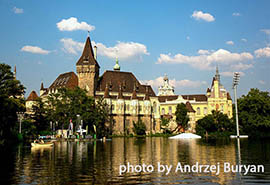
- In this City Park, there is an old castle called
Vajdahunyad. with
its history.
- This castle in on the lake side.
- This photo was taken at night time, with an impressive reflection from the lake.
- Buildings look like this in the castle yard.
- One of those buildings is for hunting museum. Hungary was originally set up by hunters.
- I had a photo of myself in front of the Castle church with an elegant-looking front. I am with two students from France.
- Don't forget. Budapest has been and still is a great
music city.
- The
National Opera House is within a walking distance from the
Vorosmarty Square or Deak Ferenc Metro Station.
See this map.
I have never been inside the hall of this opera house, but I was fortunate to see Leo Delibes's ballet "Coppelia" performed at the Vienna Opera House.
- Franz Liszt Square is
within a walking distance from the opera house.
See this map.
- His statue with long fingers is at the center of the Square. It was a honor for me to have a photo with him.
- There are many restaurants in this Square.
- This restaurant is one of the expensive places.
-
Bela Bartok was also one of the great composers of the
20th Century.
- I spotted his statue in the Margarita Island ,and had a photo of myself next to him in 2003, but I am not able to find the photo.
- In 2008, I saw his opera "Bluebeard's Castle" at the La Scala Opera House in Milan.
-
Zoltan Kodaly was also a great Hungarian composer.
- I have a photo of myself next to
Kodaly's statue in the
Margarita Island.
I was with a tour guide.
- While he was on the faculty of Eotvos university, he had
a Korean student named Ahn Ik-tai. Before coming to
Budapest, Ahn had composed "Symphonic Fantasia Korea," whose
finale became the national anthem of Korea. Under Kodaly's
guidance, he added final touch-ups to his work.
Ahn's statue is in the City Park, and I had a photo of a photo of myself next to his statue (2013). I was very happy to be there since I shook hands with him at a gathering of Koreans in New York, right after I got my PhD degree in 1961.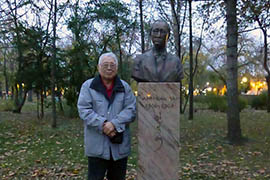
While Ahn was studying in Budapest, his country was under Japanese occupation, and he was a country-less man. Hungarians were very nice to him.
- I have a photo of myself next to
Kodaly's statue in the
Margarita Island.
I was with a tour guide.
- In 2003, I was fortunate enough to
meet three Korean musicians near Vaci Street and to have
pizza with them, and I had
this photo with them. They told me about Hungarian
music and musicians.
They seem to be doing well in Budapest. They also told me
it is easy for them to speak Hungarian because it shares
the same linguistic origin as the Korean language.

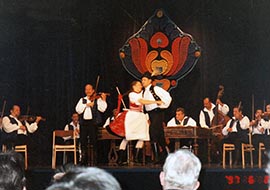
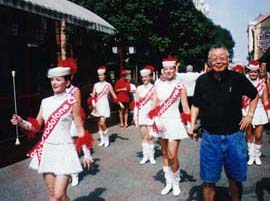
- You do not have to be a professional musician
to enjoy music. If I am able to write this section of the
webpage, I must be a music lover. See also
my music page, but I am musically illiterate. I
cannot make sense out of those bean sprouts spread over
five horizontal lines.
I do not know how many Hungarians are professional musicians, but every Hungarian seems to be a music lover. Wherever I go in Hungary, I see music scenes.
- Sing and tell on the Castle Hill, Budapest.
- High School Orchestra
on the Castle Hill.
- Park Musicians in Budapest.
- Folk Music Theater somewhere in the Buda side of Budapest.
- Hungarians love to dance. photo taken in Pecs.
- High school band in Pecs.
- Coffee shop on Vaci Street
- Russian restaurant called Tchaikovsky near the Vorosmarty Square.
It is safe to say that Hungary's music-loving culture produced so many great composers.
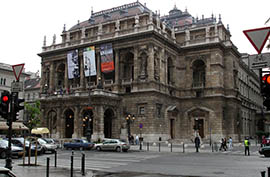
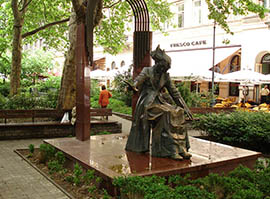
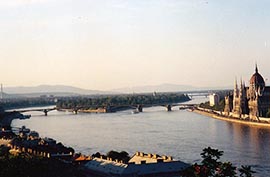
This photo tells where
the Margarita Island is.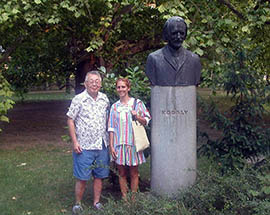
- The
National Opera House is within a walking distance from the
Vorosmarty Square or Deak Ferenc Metro Station.
See this map.
- This page is still under construction, Please come again.
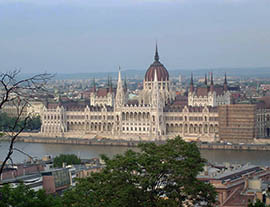
|
copyright@2014 by Y. S. Kim, unless otherwise specified. You may send your comments to yskim@ysfine.com.
|
- Click here for his home page.
- His photo-biography.
- His Einstein page.
- His Princeton page.
- His Style page.

I received my PhD degree from Princeton in 1961, seven years after high school graduation in 1954. This means that I did much of the ground work for the degree during my high school years.
